Coupling of Modes in Step-Index Plastic Optical Fibers by Using D-Shape Technique
Abstract
:1. Introduction
2. Modes and Coupling
3. Material and Methods, Components, and Experimental Setup
- Collecting the light: The first step consists of collecting the light at the ends of the POFs with lengths z1 and z2, where z1 and z2 are lengths of the POF with z > 0 [25]. To capture the light at the exit of the POF, a CCD is positioned 2 mm from the end face of the POF.
- Image processing: We then transferred the image obtained by the CCD to ImageJ 1.53r software. This platform allows for not only detailed visualization of the image but also precise extraction of the numerical data related to the angular light power distribution.
- Statistical analysis in Origin: With the angular light power distribution curve data obtained by far-field imaging using ImageJ software, we proceeded to perform a statistical analysis using Origin 2019b software. This software was used to calculate the variance in the angular light power distribution for lengths z1 and z2 of the POF.
4. Experimental Results
5. Discussion and Bit Error Rate (BER) Test
6. Conclusions
Author Contributions
Funding
Institutional Review Board Statement
Informed Consent Statement
Data Availability Statement
Acknowledgments
Conflicts of Interest
References
- Ziemann, O.; Krauser, J.; Zamzow, P.E.; Daum, W. Installation POF Handbook, Optical Short Range Transmission Systems, 2nd ed.; Springer: Berlin/Heidelberg, Germany, 2008. [Google Scholar]
- Savović, S.; Simović, A.; Drljača, B.; Kovačević, M.S.; Kuzmanović, L.; Ivanović, M.; Djordjevich, A.; Aidinis, K.; Tosi, D.; Min, R. High Bandwidth Performance of Multimode Graded-Index Micro Structured Polymer Optical Fibers. Results Phys. 2023, 50, 106548. [Google Scholar] [CrossRef]
- Weinert, A. Plastic Optical Fibers-Principles, Components, and Installation; SIEMENS: Munich, Germany, 1999. [Google Scholar]
- Al-Zubaidi, F.M.A.; Montero, D.S.; Vásquez, C. SI-POF Supporting Power-Over-Fiber in Multi-Gbit/s Transmission for In-Home Networks. J. Light. Technol. 2021, 39, 112–121. [Google Scholar] [CrossRef]
- Huiszoon, B.; de Laat, M.M.; Shi, Y.; Eman, B.; van den Hoven, G.N. Beyond a Gigabit on Plastic Optical Fibre at the FTTH Gateway. In Proceedings of the 2013 15th International Conference on Transparent Optical Networks (ICTON), Cartagena, Spain, 23–27 June 2013. [Google Scholar]
- Truong, T.K. Boeing Commercial Airplanes Fiber Optic Evolution—Applications of POF in Commercial Aircraft. In Proceedings of the POF Symposium in Optical Fiber Communication Conference (OFC 2016), Anaheim, CA, USA, 20–24 March 2016. [Google Scholar]
- Savović, S.; Simović, A.; Drljača, B.; Kovačević, M.S.; Kuzmanović, L.; Djordjevich, A.; Aidinis, K.; Min, R. Power Flow in Multimode Graded-Index Microstructured Polymer Optical Fibers. Polymers 2023, 15, 1474. [Google Scholar] [CrossRef] [PubMed]
- Broadway, C.; Min, R.; Leal-Junior, A.G.; Marques, C.; Caucheteur, C. Toward Commercial Polymer Fiber Bragg Grating Sensors: Review and Applications. J. Light. Technol. 2019, 37, 2605–2615. [Google Scholar] [CrossRef]
- Breyer, F.; Moerz, M.; Hanik, N.; Li, L.; Randel, S.; Spinnler, B. Analysis of Electronic Dispersion Compensation for Step-index Polymer Optical Fibre by Use of an Advanced Simulation Model. Eur. Trans. Telecommun. 2007, 18, 881–886. [Google Scholar] [CrossRef]
- Drljača, B.; Savović, S.; Djordjevich, A. Calculation of the frequency response in step-index plastic optical fibers using the time-dependent power flow equation. Opt. Lasers Eng. 2011, 49, 618–622. [Google Scholar] [CrossRef]
- Drljača, B.; Savović, S.; Djordjevich, A. Calculation of the frequency response and bandwidth in step-index plastic optical fibers using the time-dependent power flow equation. Phys. Scr. 2012, 2012, 014028. [Google Scholar] [CrossRef]
- Dugas, J.; Maurel, G. Mode-coupling Processes in Polymethyl Methacrylate-core Optical Fibers. Appl. Opt. 1992, 31, 5069–5079. [Google Scholar] [CrossRef] [PubMed]
- Jeunhomme, L.; Fraise, M.; Pocholle, J.P. Propagation Model for Long Step-index Optical Fibers. Appl. Opt. 1976, 15, 3040–3046. [Google Scholar] [CrossRef]
- Sequeira, F.; Cennamo, N.; Rudnitskaya, A.; Nogueira, R.; Zeni, L.; Bilro, L. D-Shaped POF Sensors for Refractive Index Sensing, The Importance of Surface Roughness. Sensors 2019, 19, 2476. [Google Scholar] [CrossRef]
- Leal-Junior, A.; Lopes, G.; Avellar, L.; Frizera, A.; Marques, C. Temperature-insensitive Water Content Estimation in Oil-water Emulsion Using POF Sensors. Opt. Fiber Technol. 2023, 76, 103240. [Google Scholar] [CrossRef]
- Savović, S.; Djordjevich, A.; Drljača, B.; Simović, A.; Min, R. Calculation of the Coupling Coefficient in Step-Index Multimode Polymer Optical Fibers Based on the Far-Field Measurements. Front. Phys. 2022, 10, 927907. [Google Scholar] [CrossRef]
- Albakay, N.A.; Nguyen, L. Achieving 1 Gbps Over Step-Index Plastic Optical Fiber Using Spatial Mode Airgap Filter. IEEE Photon. Technol. Lett. 2017, 29, 655–658. [Google Scholar] [CrossRef]
- Chandrappan, J.; Jing, Z.; Jie, N.R.; Damaruganath, P.; Lau, J. A Pluggable Large Core Step Index Plastic Optical Fiber with Built-In Mode Conditioners for Gigabit Ultra Short Reach Networks. IEEE Trans. Adv. Packag. 2010, 33, 868–875. [Google Scholar] [CrossRef]
- Kagami, M.; Kawasaki, A.; Yonemura, M.; Nakai, M.; Mena, P.V.; Selviah, D.R. Encircled Angular Flux Representation of the Modal Power Distribution and Its Behavior in a Step Index Multimode Fiber. J. Light. Technol. 2016, 34, 943–951. [Google Scholar] [CrossRef]
- Cennamo, N.; Coelho, L.; Santos, D.F.; Baptista, J.M.; Guerreiro, A.; Jorge, P.A.S.; Zeni, L. Modal Filtering for Optimized Surface Plasmon Resonance Sensing in Multimode Plastic Optical Fibers. IEEE Sens. J. 2015, 15, 6306–6312. [Google Scholar] [CrossRef]
- Vinogradov, J.; Kruglov, R.; Engelbrecht, R.; Ziemann, O.; Sheu, J.K.; Chi, K.L.; Wun, J.M.; Shi, J.W. GaN-Based Cyan Light-Emitting Diode with up to 1-GHz Bandwidth for High-Speed Transmission Over SI-POF. IEEE Photonics J. 2017, 9, 3. [Google Scholar] [CrossRef]
- Horiguchi, K.; Iikubo, T.; Beppu, Y.; Hyakutake, Y.; Sugihara, O. Low-Attenuation Variable Mode Control Using Twist Processing for Step-Index Optical Fiber Loops. IEEE Photon. Technol. Lett. 2019, 31, 1217–1220. [Google Scholar] [CrossRef]
- Simović, A.; Savović, S.; Drljača, B.; Djordjevich, A. Enhanced Bandwidth of W-type Plastic Optical Fibers Designed from Singly Clad Step-index Plastic Optical Fibers. Opt. Laser Technol. 2019, 111, 629–634. [Google Scholar] [CrossRef]
- Arrue, J.; Aldabaldetreku, G.; Durana, G.; Zubia, J.; Garces, I.; Jimenez, F. Design of Mode Scramblers for Step-Index and Graded-Index Plastic Optical Fibers. J. Light. Technol. 2005, 23, 1253–1260. [Google Scholar] [CrossRef]
- Savović, S.; Aidinis, K.; Djordjevich, A.; Min, R. Investigation of Mode Coupling in Strained and Unstrained Multimode Step-index POFs Using the Langevin Equation. Heliyon 2023, 9, e18156. [Google Scholar] [CrossRef]
- Cherin, A.H.; Head, E.D.; Lovelace, C.R.; Gardner, W.B. Selection of mandrel wrap mode filters for optical fiber loss measurements. Fiber Integr. Opt. 1982, 4, 49–66. [Google Scholar] [CrossRef]
- Gloge, D. Optical Power Flow in Multimode Fibers. Bell Syst. Tech. J. 1972, 51, 1767–1783. [Google Scholar] [CrossRef]
- Savović, S.; Djordjevich, A. Method for Calculating the Coupling Coefficient in Step-index Optical Fibers. Appl. Opt. 2007, 46, 1477–1481. [Google Scholar] [CrossRef]
- Savović, S.; Kovačević, M.S.; Djordjevich, A.; Bajić, J.S.; Stupar, D.Z.; Stepniak, G. Mode Coupling in Low NA Plastic Optical Fibers. Opt. Laser Technol. 2014, 60, 85–89. [Google Scholar] [CrossRef]
- Savović, S.; Djordjevich, A.; Savović, I.; Min, R. Mode Coupling and Steady-State Distribution in Multimode Step-Index Organic Glass-Clad PMMA Fibers. Photonics 2022, 9, 297. [Google Scholar] [CrossRef]
- Savović, S.; Djordjevich, A. Mode Coupling in Multimode Step-index Plastic-clad Silica Fibers with Corrugated Surfaces. Opt. Laser Technol. 2017, 97, 400–404. [Google Scholar] [CrossRef]
- Hurand, S.; Chauny, L.-A.; El-Rabii, H.; Joshi, S.; Yalin, A. Mode Coupling and Output Beam Quality of 100–400 µm Core Silica Fibers. Appl. Opt. 2011, 50, 492–499. [Google Scholar] [CrossRef]
- Savović, S.; Djordjevich, A.; Simović, A.; Drljača, B. Equilibrium Mode Distribution and Steady-State Distribution in 100–400 µm Core Step-index Silica Optical Fibers. Appl. Opt. 2011, 50, 4170–4173. [Google Scholar] [CrossRef]
- Mitic, D.; Lebl, A.; Markov, Z. Calculating the Required Number of Bits in the Function of Confidence Level and Error Probability Estimation. Serbian J. Electr. Eng. 2012, 9, 361–375. [Google Scholar] [CrossRef]


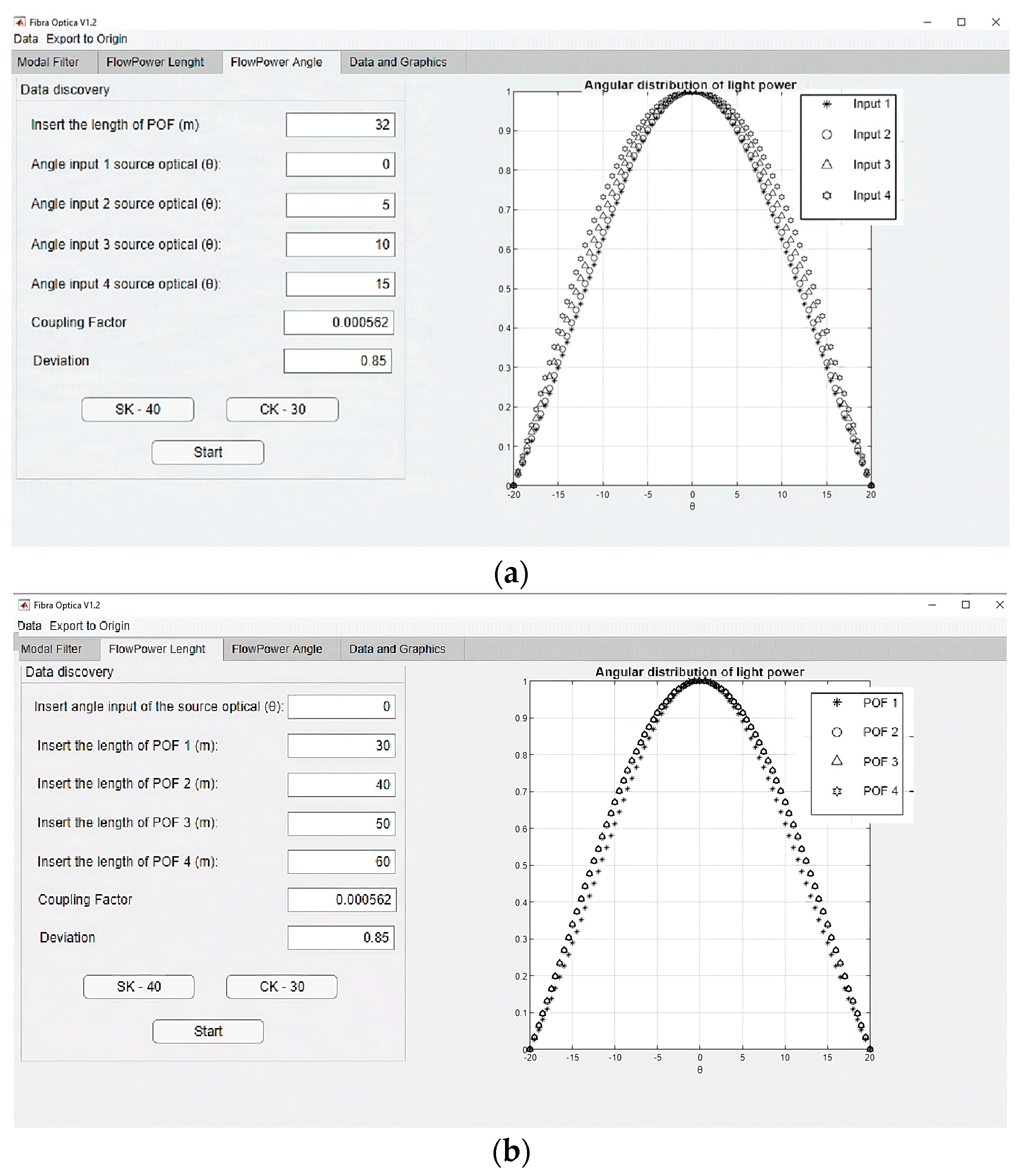
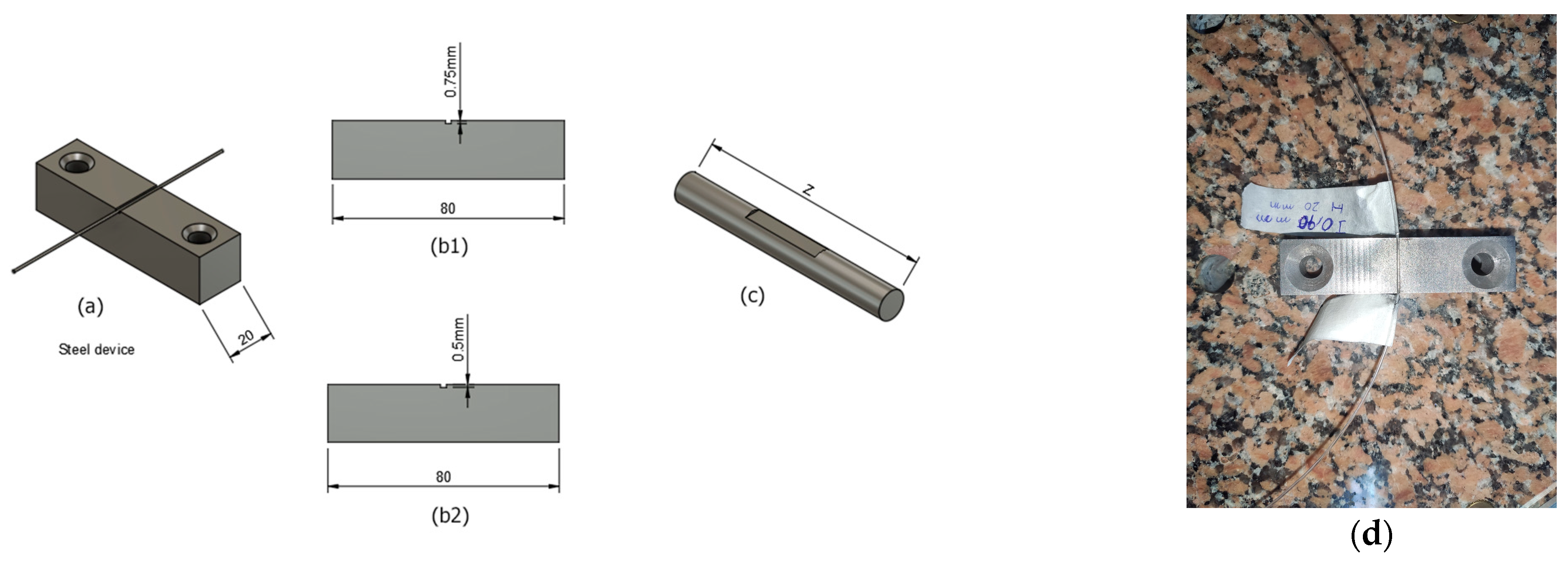



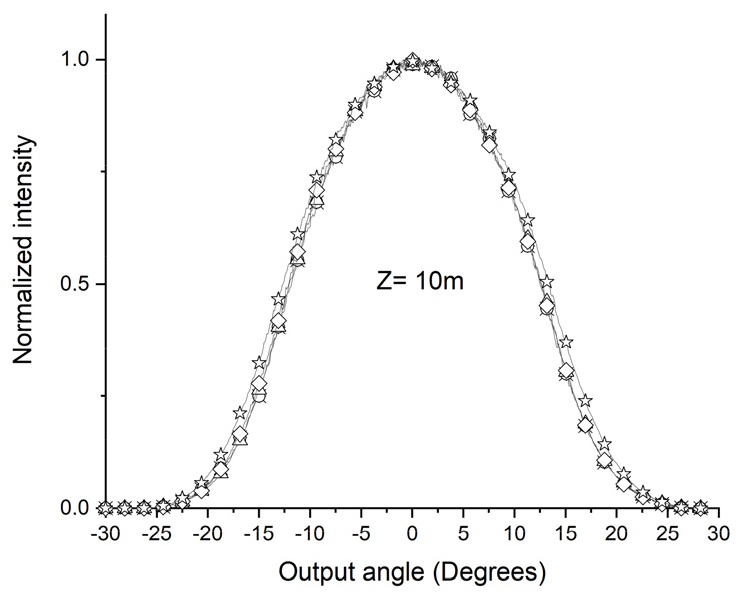

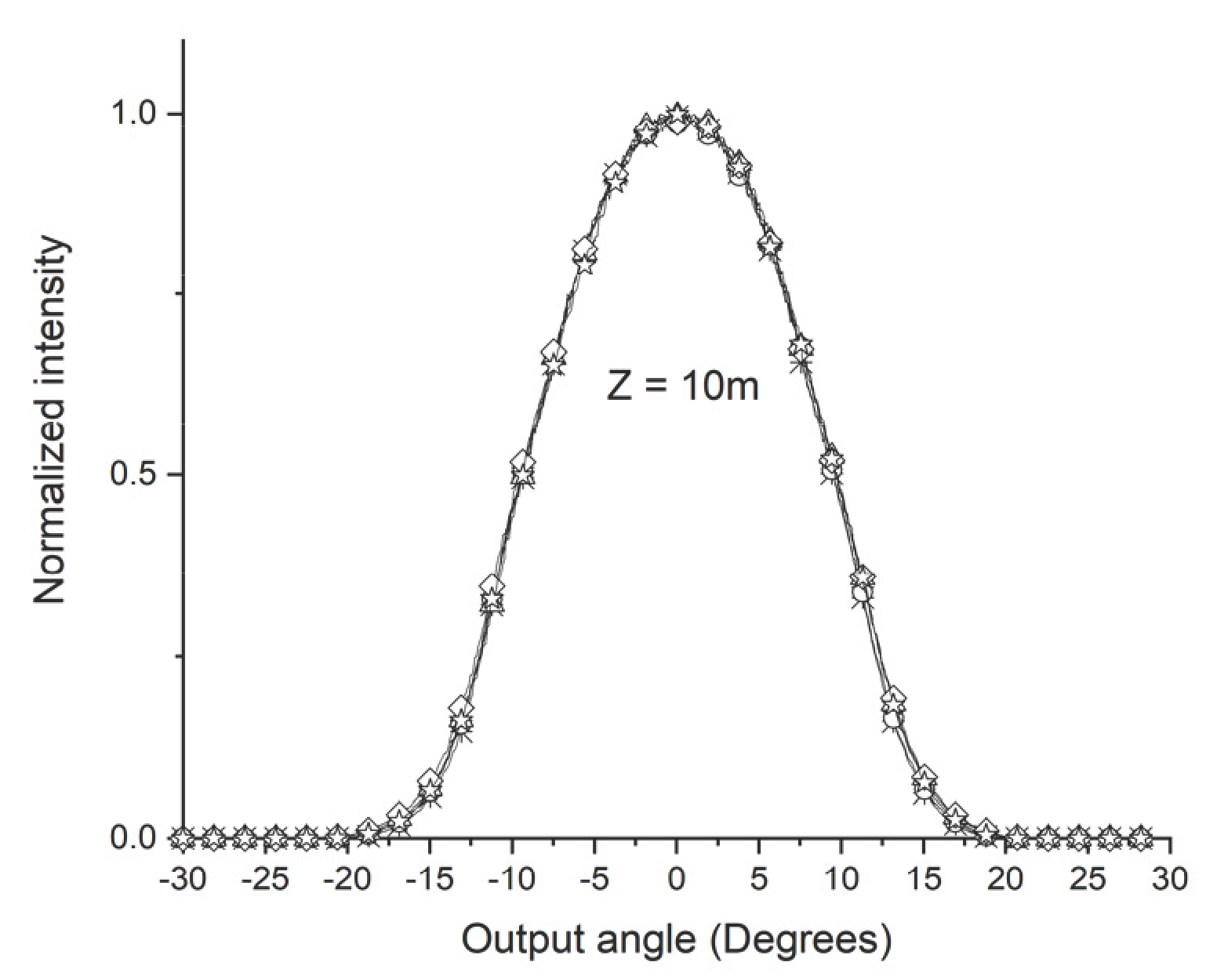


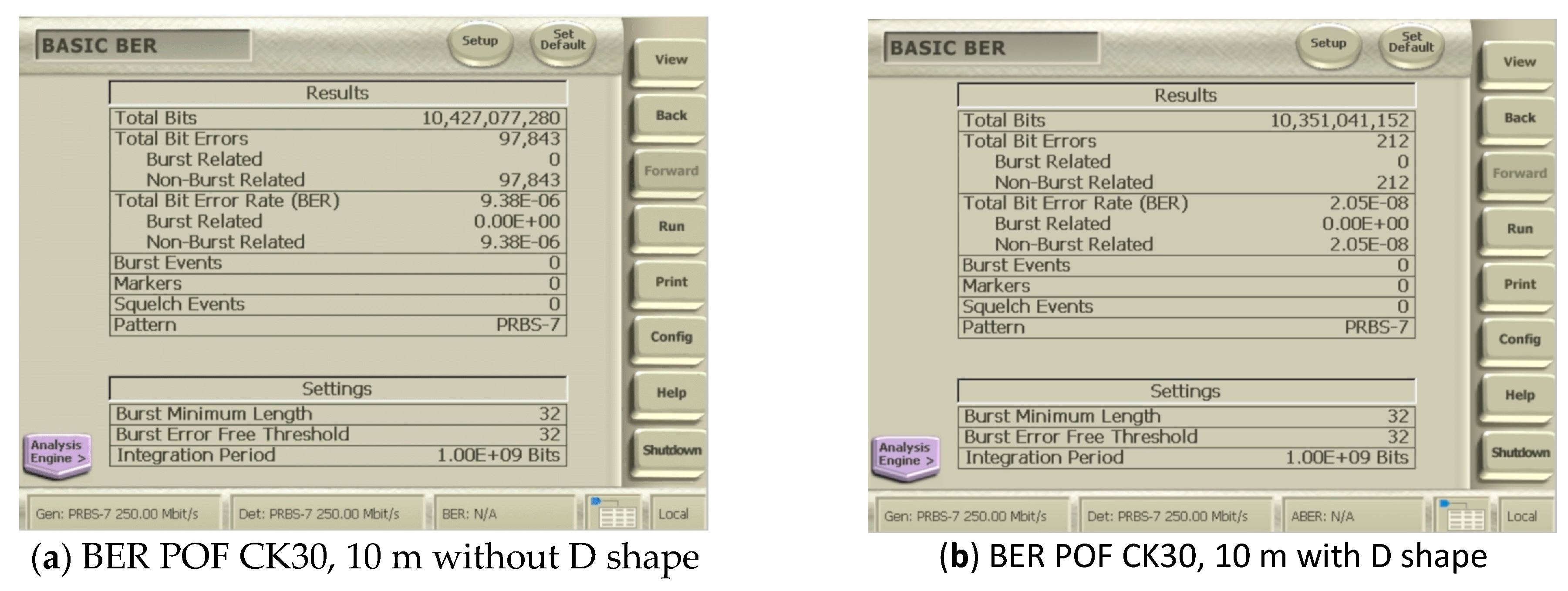
| Technique | Method | Reference |
|---|---|---|
| Mode Conditioning | To eliminate high-order modes, an element such as a lens or a specialized diffuser is used at the beginning of the fiber to control the way the light enters. | [18] |
| Offset Launch Technique | It involves coupling light off-center relative to the fiber’s axis, helping to reduce modal dispersion. | [19] |
| Modal Filters | These filters, attached to the fiber’s leading edge, allow low-order modes to pass while blocking high-order ones. | [20] |
| Narrow Spectral Width Sources | Light sources with narrow spectra and high power can minimize power transfer between modes. | [21] |
| Twist Processing for Mode Control | This method modulates modal energy distribution, encouraging energy transfer from lower to higher-order modes by twisting the fibers. | [22] |
| Refractive Index Profiling | Adjusting the fiber core’s refractive index during production can reduce high-order mode excitation. | [23] |
| Mode Scrambler | This technique aims to create controlled disturbances in the propagation modes of light within a fiber. It does this by using specially made cylinders that bend the Plastic Optical Fiber (POF). This bending process facilitates the coupling or interaction between different modes of light within the fiber, enhancing the fiber's performance for specific applications. | [24] |
| Airgap Filter | A spatial filter creates an air gap, reducing the numerical aperture and modal dispersion. | [17] |
| Microstructured POF | Designing the fiber with a specific pattern of air holes reduces the number of propagation modes, minimizing modal dispersion. | [7] |
| Strained POF | Applying strain to the fiber enhances mode coupling, reducing dispersion. | [25] |
| Mandrel Wrap | This consists of wrapping a section of optical fiber around a cylindrical mandrel of a specified diameter for several turns. This creates a bend that induces additional losses for higher-order modes without significantly affecting lower-order modes. | [26] |
| Core material | Polymethyl–Methacrylate Resin |
| Cladding material | Fluorinated Polymer |
| Core refractive index | 1.49 |
| Refractive index profile | Step Index |
| Numerical Aperture | 0.5 |
| Core diameter | 980 μm |
| Cladding diameter | 1000 μm (1 mm) |
| Transmission loss at 650 nm | 150 dB/km |
| Core material | Polymethyl–Methacrylate Resin |
| Cladding material | Fluorinated Polymer |
| Core refractive index | 1.49 |
| Refractive index profile | Step Index |
| Numerical Aperture | 0.5 |
| Core diameter | 735 μm |
| Cladding diameter | 750 μ (0.75 mm) |
| Transmission loss at 650 nm | 200 dB/km |
| Stretch of the POF under Investigation | The Variance in the Launch Beam Distribution σ² | |
|---|---|---|
| POF without D-shape | Z1 = 5 m | = 0.11328 |
| Z2 = 22 m | = 0.14279 | |
| POF with D-Shape | Z1 = 5 m | = 0.15354 |
| Z2 = 10 m | = 0.13203 |
| Mode coupling coefficient without the use of a D shape | 8.6794 × 10−4 (rad2/m) |
| Mode coupling coefficient with the use of a D shape | 2.151 × 10−3 (rad2/m) |
| Stretch of the POF under Investigation | The Variance in the Launch Beam Distribution σ2 | |
|---|---|---|
| POF without D shape | Z1 = 15 m | = 0.14397 |
| Z2 = 20 m | = 0.13229 | |
| POF with D Shape | Z1 = 5 m | = 0.1197 |
| Z2 = 10 m | = 0.14946 |
| Mode coupling coefficient without the use of a D shape | 1.168 × 10−3 (rad2/m) |
| Mode coupling coefficient with the use of a D shape | 2.976 × 10−3 (rad2/m) |
| POF SI TORAY: PFU-CD1001-22E (REF [23]) | POF SI ESKA SK40 MITSUBISHI RAYON (This Work) | POF SI ESKA CK30 MITSUBISHI RAYON (This Work) | |
|---|---|---|---|
| The refractive index of the core (n0) | 1.492 | 1.49 | 1.49 |
| Numerical aperture (NA) | 0.46 | 0.5 | 0.5 |
| Transmission loss | 150 dB/Km @ 650 nm | 150 dB/Km @ 650 nm | 200 dB/Km @ 650 nm |
| Mode coupling coefficient, D (rad²/m) | Unstrained 7.3 × 10−4 | Without D shape 8.6794 × 10−4 | Without D shape 1.191 × 10−3 |
| Strained 1.3 × 10−2 | With D shape 2.151 × 10−3 | With D shape 2.976 × 10−3 | |
| Mode Stabilization Length, Zs (m) | Unstrained 49 (experimental) 26 (calculated) | Without D shape—27 (experimental) 25.94 (calculated) | Without D shape 20 (experimental) 19.3 (calculated) |
| Strained 2.5 (experimental) 1.46 (calculated) | With D shape 10 m (experimental) 10.4 (calculated) | With D shape 5~10 (experimental) 7.57 (calculated) | |
| Core diameter (mm) | 1000 μm | 980 μm | 735 μm |
| Length | BER without D Shape | BER with D Shape | Ratio |
|---|---|---|---|
| 1 | 7.6 × 10−7 | 3.7 × 10−10 | 2054 |
| 3 | 4.57 × 10−7 | 6.8 × 10−8 | 6.7 |
| 10 | 9.38 × 10−6 | 2.0 × 10−8 | 469 |
| 20 | 1.2 × 10−7 | 8.8 × 10−8 | 1.36 |
| 30 | 1.03 × 10−6 | 4.8 × 10−7 | 2.5 |
Disclaimer/Publisher’s Note: The statements, opinions and data contained in all publications are solely those of the individual author(s) and contributor(s) and not of MDPI and/or the editor(s). MDPI and/or the editor(s) disclaim responsibility for any injury to people or property resulting from any ideas, methods, instructions or products referred to in the content. |
© 2024 by the authors. Licensee MDPI, Basel, Switzerland. This article is an open access article distributed under the terms and conditions of the Creative Commons Attribution (CC BY) license (https://creativecommons.org/licenses/by/4.0/).
Share and Cite
Silva, C.M.F.; Pacheco, G.M.; Panasiewicz, J.; Ramirez, L.A.R. Coupling of Modes in Step-Index Plastic Optical Fibers by Using D-Shape Technique. Sensors 2024, 24, 2707. https://doi.org/10.3390/s24092707
Silva CMF, Pacheco GM, Panasiewicz J, Ramirez LAR. Coupling of Modes in Step-Index Plastic Optical Fibers by Using D-Shape Technique. Sensors. 2024; 24(9):2707. https://doi.org/10.3390/s24092707
Chicago/Turabian StyleSilva, Cláudio Márcio F., Gefeson M. Pacheco, Jognes Panasiewicz, and Luis A. Rabanal Ramirez. 2024. "Coupling of Modes in Step-Index Plastic Optical Fibers by Using D-Shape Technique" Sensors 24, no. 9: 2707. https://doi.org/10.3390/s24092707





